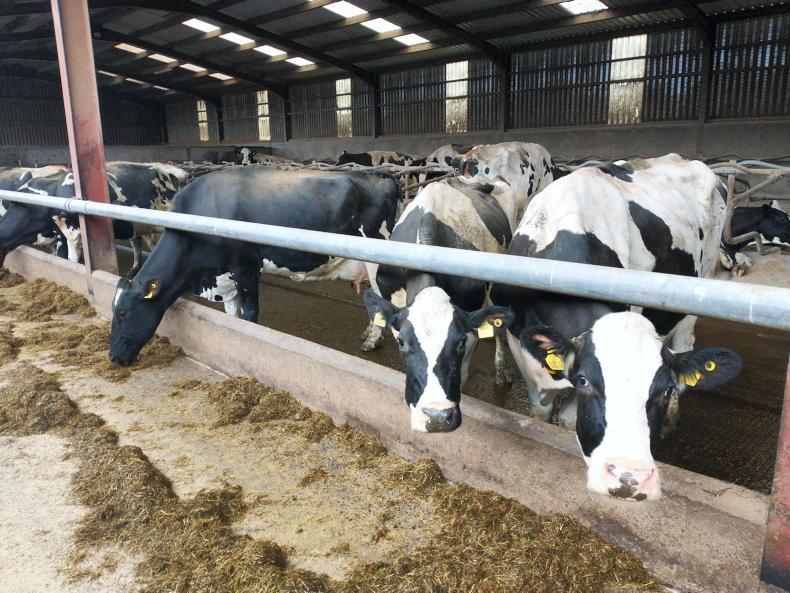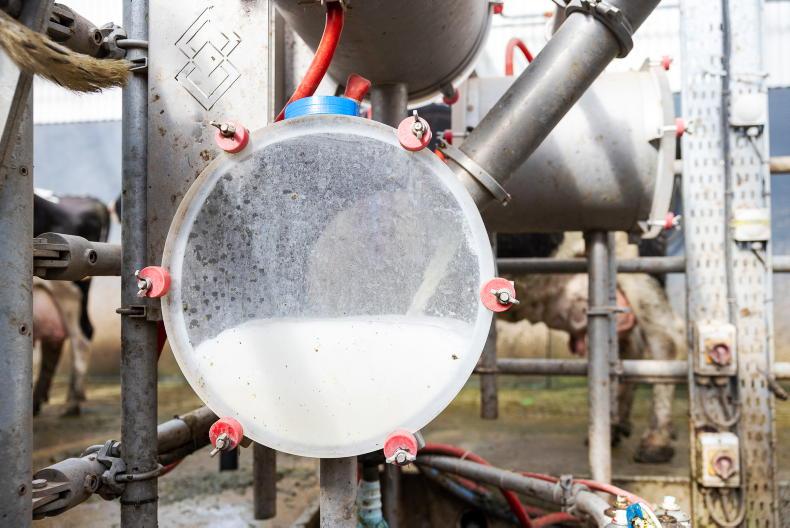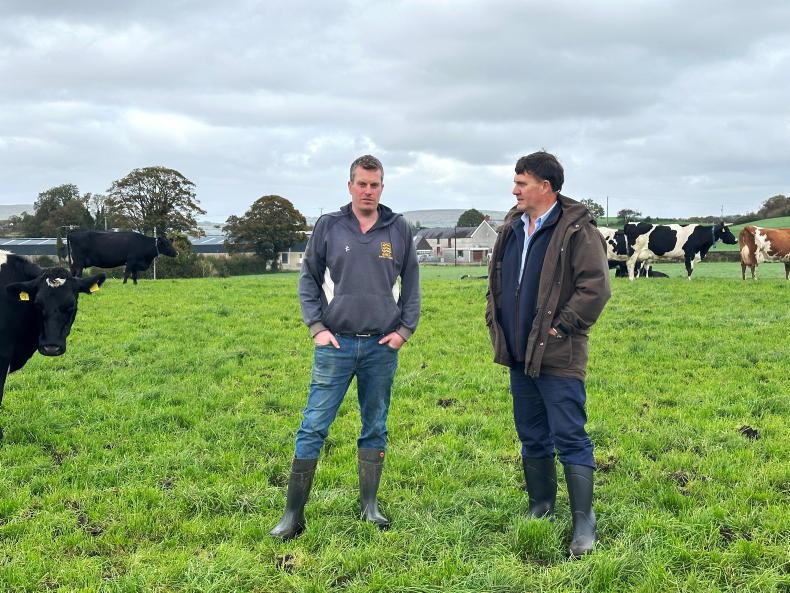Having graduated to a confinement system, and then on to zero grazing during summer months, 2022 is the third year that cows have been back out grazing on the farm of Stephen and David Jackson, outside Bangor in Co Down.
Hosting the first post-COVID-19 farm walk organised by the Ulster Grassland Society (UGS) on Tuesday, Stephen Jackson told a large crowd of visitors that the main factor behind his decision to stop zero grazing was labour. “I got that big a sickening from it. It was just too full on. I wanted to step back,” he said.
With the machine now sold, he is committed to grazing grass again, although is still refining his grassland management skills, and has more work to do around paddock infrastructure, currently relying mainly on strip grazing. He is using a plate metre to measure grass, with the aim to go in at 2,900kg dry matter per hectare (DM/ha) and graze down to 1,700kg DM/ha.
Where grass goes above 3,000kg it is taken out for silage. Paddocks are topped as necessary and when time allows, but Stephen is not keen on going down the route of pre-mowing. “If I am going pre-mowing every day, I may as well zero-graze,” he suggested.
Split
The Jacksons milk 260 autumn- and winter-calving cows, split into high- and low-yielding groups. The highs remain housed full-time, while the low-yielders go out to grass once conditions allow in the spring. At present, 50 acres have been allocated for grazing, although up to 130 acres are available around the yard.

Close up dry cows are fed haylage made from grass that received no slurry, along with 2.5kg of a blend that includes bypass protein, minerals and anionic salts
“I had 70 cows out last year. I would like to get to 100 this year,” said Stephen, who explained that to move into the low group cows must be pregnant, and yielding under 32 litres. During the winter, this group are offered ad-lib silage, and fed to yield in the parlour. Average yield is currently 27 litres. The first cows in the low group are likely to be dried off by the end of May, ahead of August calving.
High group
The high group are offered a total mixed ration (TMR) set to maintenance plus 28 litres, with cows topped up in the parlour with an 18% protein nut at a rate of 0.45kg per litre. The TMR includes first-, second- and fourth-cut silage and 8.5kg of a dairy blend. Average yield per cow in the high group is around 39 litres, with a number of cows doing over 60 litres on twice-a-day milking.
Herd average
Across the entire herd, cows produced an average of 10,238 litres at 3.93% butterfat and 3.32% protein in 2021/22, giving total milk solids per cow of 764kg. Just over 3.5t of concentrate per cow was fed, giving a feed rate of 0.35kg per litre. Milk from forage stands at 3,003 litres.
“I would like to push milk from forage on a bit further – I would like to get another 500 litres,” confirmed Stephen, who said that ultimately his target is to produce 10,000 litres on 3t of concentrate.
Achieving those targets will require attention to detail across a number of areas.
One of the main aims at present is to tighten the calving pattern, both to ease labour requirements, and also to avoid the inefficiencies that can occur when milking late-lactation cows.
No calvings are due to take place in June or July 2022, with just 12 cows calved in April and only a handful due in May.
The next aim is not to have any cows calving between April and July, and
ultimately calve the entire herd in the August to January period.

The high-yielding group on the Jackson farm are housed full-time.
Sexed semen is used in high-index cows and heifers to breed replacements. With the use of sexed semen now complete for this breeding season, it means all potential replacements will be born by the end of January next year.
All breeding work on the Jackson farm is udertaken by Genus Reproductive Management Systems (RMS) technicians.
Genomic testing is also done to identify animals with good fat and protein, and fertility traits.
“I would like to get higher fat and protein, but I don’t want to give up on litres of milk. I do believe there are cows out there that will do both. Genomics opens up a mass of options,” said Stephen.
Multi-cut delivering
high-quality silage
With a spike in red diesel costs contributing to higher silage contractor charges in 2022, analysis by CAFRE has suggested that this is likely to mean costs per tonne of dry matter for four- or five-cut systems come out significantly ahead of a three-cut system.
However, Stephen Jackson does not intend moving away from his four-cut system this year and, as shown in Table 1, it delivered some exceptional silage in 2021.
Speaking at the event on Tuesday, local dairy consultant Jason McMinn argued that by making high-quality silage, it can help keep the concentrate feed rate down. “If you can utilise the silage correctly, the benefits of a multi-cut system still outweigh the extra contractor costs,” he said.
Nutrition advice on the Jackson farm is provided by Gareth Anderson from Farmgate Nutrition, who pointed out that while silage dry matters in 2021 are probably too high (risk of spoilage etc), it is much easier to formulate a TMR with dry rather than wet silages.
No hay or straw is included in the TMR. “It takes up space,” suggested Stephen Jackson.
Breakeven milk
price at 35p/l
The breakeven milk price on the Jackson farm was calculated in 2021 to be 28p/l, but with adjustments made to allow for higher fertiliser, meal and energy costs, that breakeven price is projected to be around 35p/l this year, confirmed Jason McMinn.
The farm had been closed due to TB, but the Jacksons have recently been able to sell surplus dairy stock and beef cattle, while milk prices have been moving in the right direction.
“I was more worried about costs three to four weeks ago than I am now. But I will keep an eye on things,” said Stephen.
Two months ago he installed a diesel generator to try to take down energy costs on the farm, which were approaching £5,000 per month. The generator operates for 12 to 14 hours per day at peak times, and it is currently costing around £2,600 to £2,700 per month in running costs. Add in £800 of other energy costs to cover off peak, it works out at a saving around £1,400 per month.
“It is a quick fix for now to control costs. I will look at other things (such as solar) down the line,” said Stephen.
Read more
NI milk compares well in a rising market
Farmers protecting the nation’s carbon
Having graduated to a confinement system, and then on to zero grazing during summer months, 2022 is the third year that cows have been back out grazing on the farm of Stephen and David Jackson, outside Bangor in Co Down.
Hosting the first post-COVID-19 farm walk organised by the Ulster Grassland Society (UGS) on Tuesday, Stephen Jackson told a large crowd of visitors that the main factor behind his decision to stop zero grazing was labour. “I got that big a sickening from it. It was just too full on. I wanted to step back,” he said.
With the machine now sold, he is committed to grazing grass again, although is still refining his grassland management skills, and has more work to do around paddock infrastructure, currently relying mainly on strip grazing. He is using a plate metre to measure grass, with the aim to go in at 2,900kg dry matter per hectare (DM/ha) and graze down to 1,700kg DM/ha.
Where grass goes above 3,000kg it is taken out for silage. Paddocks are topped as necessary and when time allows, but Stephen is not keen on going down the route of pre-mowing. “If I am going pre-mowing every day, I may as well zero-graze,” he suggested.
Split
The Jacksons milk 260 autumn- and winter-calving cows, split into high- and low-yielding groups. The highs remain housed full-time, while the low-yielders go out to grass once conditions allow in the spring. At present, 50 acres have been allocated for grazing, although up to 130 acres are available around the yard.

Close up dry cows are fed haylage made from grass that received no slurry, along with 2.5kg of a blend that includes bypass protein, minerals and anionic salts
“I had 70 cows out last year. I would like to get to 100 this year,” said Stephen, who explained that to move into the low group cows must be pregnant, and yielding under 32 litres. During the winter, this group are offered ad-lib silage, and fed to yield in the parlour. Average yield is currently 27 litres. The first cows in the low group are likely to be dried off by the end of May, ahead of August calving.
High group
The high group are offered a total mixed ration (TMR) set to maintenance plus 28 litres, with cows topped up in the parlour with an 18% protein nut at a rate of 0.45kg per litre. The TMR includes first-, second- and fourth-cut silage and 8.5kg of a dairy blend. Average yield per cow in the high group is around 39 litres, with a number of cows doing over 60 litres on twice-a-day milking.
Herd average
Across the entire herd, cows produced an average of 10,238 litres at 3.93% butterfat and 3.32% protein in 2021/22, giving total milk solids per cow of 764kg. Just over 3.5t of concentrate per cow was fed, giving a feed rate of 0.35kg per litre. Milk from forage stands at 3,003 litres.
“I would like to push milk from forage on a bit further – I would like to get another 500 litres,” confirmed Stephen, who said that ultimately his target is to produce 10,000 litres on 3t of concentrate.
Achieving those targets will require attention to detail across a number of areas.
One of the main aims at present is to tighten the calving pattern, both to ease labour requirements, and also to avoid the inefficiencies that can occur when milking late-lactation cows.
No calvings are due to take place in June or July 2022, with just 12 cows calved in April and only a handful due in May.
The next aim is not to have any cows calving between April and July, and
ultimately calve the entire herd in the August to January period.

The high-yielding group on the Jackson farm are housed full-time.
Sexed semen is used in high-index cows and heifers to breed replacements. With the use of sexed semen now complete for this breeding season, it means all potential replacements will be born by the end of January next year.
All breeding work on the Jackson farm is udertaken by Genus Reproductive Management Systems (RMS) technicians.
Genomic testing is also done to identify animals with good fat and protein, and fertility traits.
“I would like to get higher fat and protein, but I don’t want to give up on litres of milk. I do believe there are cows out there that will do both. Genomics opens up a mass of options,” said Stephen.
Multi-cut delivering
high-quality silage
With a spike in red diesel costs contributing to higher silage contractor charges in 2022, analysis by CAFRE has suggested that this is likely to mean costs per tonne of dry matter for four- or five-cut systems come out significantly ahead of a three-cut system.
However, Stephen Jackson does not intend moving away from his four-cut system this year and, as shown in Table 1, it delivered some exceptional silage in 2021.
Speaking at the event on Tuesday, local dairy consultant Jason McMinn argued that by making high-quality silage, it can help keep the concentrate feed rate down. “If you can utilise the silage correctly, the benefits of a multi-cut system still outweigh the extra contractor costs,” he said.
Nutrition advice on the Jackson farm is provided by Gareth Anderson from Farmgate Nutrition, who pointed out that while silage dry matters in 2021 are probably too high (risk of spoilage etc), it is much easier to formulate a TMR with dry rather than wet silages.
No hay or straw is included in the TMR. “It takes up space,” suggested Stephen Jackson.
Breakeven milk
price at 35p/l
The breakeven milk price on the Jackson farm was calculated in 2021 to be 28p/l, but with adjustments made to allow for higher fertiliser, meal and energy costs, that breakeven price is projected to be around 35p/l this year, confirmed Jason McMinn.
The farm had been closed due to TB, but the Jacksons have recently been able to sell surplus dairy stock and beef cattle, while milk prices have been moving in the right direction.
“I was more worried about costs three to four weeks ago than I am now. But I will keep an eye on things,” said Stephen.
Two months ago he installed a diesel generator to try to take down energy costs on the farm, which were approaching £5,000 per month. The generator operates for 12 to 14 hours per day at peak times, and it is currently costing around £2,600 to £2,700 per month in running costs. Add in £800 of other energy costs to cover off peak, it works out at a saving around £1,400 per month.
“It is a quick fix for now to control costs. I will look at other things (such as solar) down the line,” said Stephen.
Read more
NI milk compares well in a rising market
Farmers protecting the nation’s carbon











SHARING OPTIONS